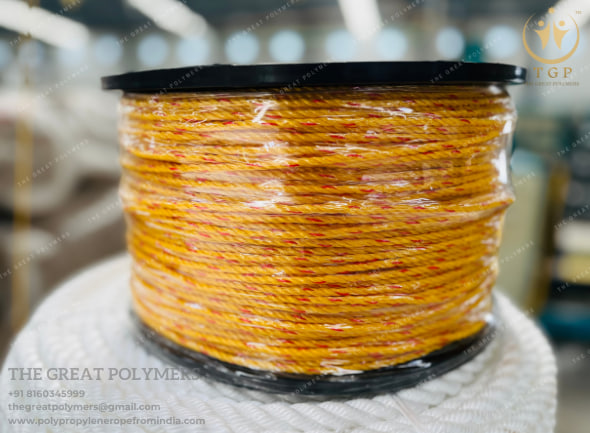Polypropylene (PP) rope, often referred to simply as “PP rope,” is a popular choice for various applications due to its versatility, durability, and cost-effectiveness. This synthetic rope is widely used in marine, construction, agriculture, and household settings. In this article, we’ll delve into the characteristics, uses, advantages, and maintenance of polypropylene rope, along with safety considerations and environmental impact.
Introduction to Polypropylene (PP) Rope
Polypropylene rope is a type of synthetic rope made from polypropylene fibers. It is known for its lightweight nature, buoyancy, and resistance to abrasion and moisture. PP rope is available in various thicknesses and lengths to suit different needs, making it a versatile option for both professional and recreational purposes.

Properties of Polypropylene Rope
Durability
One of the key properties of polypropylene rope is its durability. It is resistant to rot, mildew, and moisture, making it ideal for outdoor use in harsh conditions.
Strength
Despite its lightweight construction, polypropylene rope offers considerable strength, making it suitable for heavy-duty applications.
Resistance to Chemicals
PP rope is highly resistant to most chemicals, acids, and alkalis, ensuring its integrity even in corrosive environments.
UV Resistance
Unlike some other materials, polypropylene rope exhibits excellent resistance to UV radiation, prolonging its lifespan when exposed to sunlight.
Uses of Polypropylene (PP) Rope
Marine Applications
Polypropylene rope is commonly used in the marine industry for mooring lines, towing lines, and general rigging due to its buoyancy and resistance to saltwater corrosion.
Construction Industry
In construction, PP rope finds applications in scaffolding, tying down loads, and general purpose lifting and securing.
Agriculture
Farmers utilize polypropylene rope for fencing, animal tethering, and bundling crops thanks to its strength and weather resistance.
Household Purposes
From clotheslines to DIY projects, polypropylene rope serves a variety of purposes around the house and garden.
Advantages of Polypropylene (PP) Rope
Cost-Effective
PP rope is an affordable option compared to other synthetic ropes, making it a budget-friendly choice for various applications.
Lightweight
Its lightweight nature makes handling and transporting polypropylene rope easy and convenient.
Floats on Water
The buoyancy of PP rope makes it an excellent choice for water-related activities such as boating and water sports.
Choosing the Right Polypropylene (PP) Rope
When selecting polypropylene rope, consider factors such as thickness, length, and construction type (twisted or braided) to ensure it meets your specific requirements.
Maintenance Tips for Polypropylene (PP) Rope
To prolong the lifespan of your PP rope, regularly clean it, store it away from direct sunlight, and inspect it for signs of wear and tear.
Safety Precautions When Using Polypropylene (PP) Rope
Always adhere to weight capacity limits, use proper knotting techniques, and inspect your rope before each use to prevent accidents and injuries.
Environmental Impact of Polypropylene (PP) Rope
While polypropylene is not biodegradable, some recycling options exist, and innovations are underway to develop more eco-friendly alternatives.
Comparison with Other Rope Materials
Polypropylene rope offers distinct advantages over other materials such as nylon and polyester in terms of cost, buoyancy, and chemical resistance.
Polypropylene (PP) Rope in Emergency Situations
Its durability and versatility make polypropylene rope an essential item in emergency kits for activities like camping, hiking, and survival situations.
Innovations in Polypropylene (PP) Rope Manufacturing
Advancements in rope manufacturing technology continue to improve the performance and sustainability of polypropylene rope.
Future Trends and Market Outlook
The demand for polypropylene rope is expected to rise as industries seek cost-effective and durable solutions for various applications.
Conclusion
Polypropylene (PP) rope offers a cost-effective and versatile solution for a wide range of applications. Its durability, strength, and resistance to environmental factors make it a preferred choice for marine, construction, agricultural, and household use. By understanding its properties, uses, and maintenance requirements, users can harness the full potential of polypropylene rope while ensuring safety and longevity.
FAQs
What is the breaking strength of polypropylene rope? Polypropylene rope’s breaking strength varies depending on its diameter and construction but generally ranges from several hundred to several thousand pounds.
Can polypropylene rope be spliced? Yes, polypropylene rope can be spliced using appropriate techniques to create loops or join two rope ends together.
Is polypropylene rope suitable for outdoor use? Yes, polypropylene rope is well-suited for outdoor use due to its resistance to moisture, UV radiation, and chemicals.
How long does polypropylene rope last? The lifespan of polypropylene rope depends on various factors such as usage, exposure to environmental conditions, and maintenance practices but can last several years with proper care.









Leave a reply